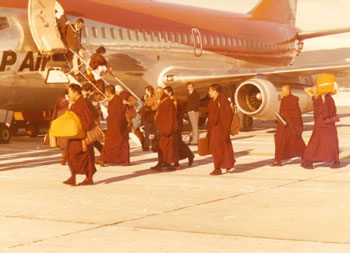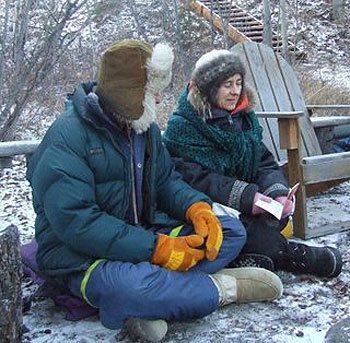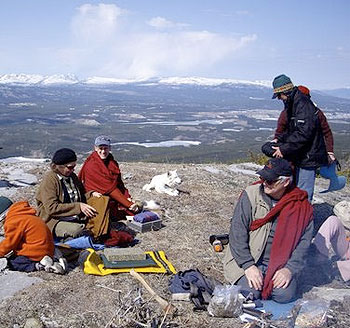Yukon Dharma Gold
The roots of Vajrayana Buddhism were first planted in the Yukon in 1973 with the visit to Whitehorse, capital of the province, by Tsengyur Rinpoche. A small practice group developed that eventually transformed into a Kagyu center and a Nyingma center. In March 1977 His Holiness the Sixteenth Gyalwa Karmapa, accompanied by H.E. Jamgon Kongtrul Rinpoche and an entourage of senior Kagyu lamas, traveled to Whitehorse. Many other important Vajrayana teachers have visited as well, including the late Chagdud Tulku Rinpoche, who founded the Rigdrol Dechen Ling Society there in 1984.
Cheryl Buchan, a board member of Rigdrol Dechen Ling-Vajra North in Whitehorse, kindly agreed to be interviewed for this profile welcoming the first Yukon member group to the Northwest Dharma Association.


The Black Hat of the 16th Karmapa arriving at Whitehorse airport with entourage, including Khenpo Khartar Rinpoche, in 1977.
Photo: John Hatch.
Caterina: Growing up in a place where anything below 60 degrees Fahrenheit was considered blizzard conditions, I was fascinated by the Yukon lifestyle described to me by one of your sangha members. She lived in a very remote area that was snowed in for at least 6 months, and the only transportation was mushing with a team of dogs. This lifestyle she said naturally lent itself to retreat. Can you comment further on what it is like to live there?
Cheryl: People here are very individualistic in their lifestyles. The land and remote aspect of life lend themselves to people developing their own ways to sustain themselves and have fun. We have only five hours of light in the winter months. It starts snowing from October until April and it can get very cold. But, these are all good conditions for study, creating and appreciating art, meeting with people, pursuing winter sports, and, of course, meditation! In the summer, there is darkness for only about two hours a day. Midnight forays into the bush by boat, bike, horse or foot are common.

Sangha members on Montana Mountain in 2007 after prayer flag and banner raising and smoke offering. Land there was donated to His Holiness the Karmapa in the 1970's.
Photo: Cheryl Buchan.
Caterina: How did you come to live there?
Cheryl: I’m from New Orleans and married a Canadian 31 years ago. We moved to the north for economic reasons and to raise our three children in a small community.
People who live here are from all over Canada—from the Maritimes, the plains, and south on the West Coast. We have a large French Canadian population here. There were times when as much as a third of our sangha were of French Canadian heritage.
Caterina: How did you connect with Buddhism in the Yukon?
Cheryl: I came to Buddhism here in Whitehorse in 1992. Although I knew about Buddhism all my adult life, I did not take refuge until then. At that time Linda (Damchos) Douma lived here.
Caterina: Is this the same Linda Douma who was Miss Canada in 1965?
Cheryl: Yes. She had lived in the refugee camp in Bir, India, with Chagdud Rinpoche and many others for eleven years. She was fluent in Tibetan and so made the Dharma available to us through her translations. It is remarkable that she lived here, so far north. It was she who made it possible for both Gangteng Rinpoche from Bhutan as well as Chagdud Rinpoche to come here. We have been incredibly fortunate.

Sangha members Marc and Marie-France practicing the Riwo Sangchod ritual in the far north at Lake Laberge, Yukon in 2006.
Photo: Cheryl Buchan.
Caterina: There was a Buddhist consciousness earlier in the area, yes?
Cheryl: We were blessed by very great Rinpoches coming here in the 70's to bless the land and people. These lamas were sponsored by a group interested in Buddhism under Nyamgyal Rinpoche—a Canadian-born western person who was recognized by the 16th Karmapa to be a tulku (a reincarnate lama). Land on Montana Mountain was given to the Karmapa at the time His Holiness visited Whiehorse and we return to it annually to refresh the prayer flags.
Caterina: There seems to be quite a connection with the First Nations people—as practitioners and as audience attending these events?
Cheryl: The First Nations are particularly interested to hear the Tibetan Rinpoches when they visit our community.
When His Holiness the Sixteenth Karmapa was here, he met with the Carcross—Tagish First Nations people in their traditional territory of Carcross at the foot of Montana Mountain. On another occasion an Elder from that nation was brought to meet him. The great Karmapa touched his cheek then the cheek of the Elder and said, "same people, same, same".
Caterina: Yukon is very blessed to have had this contact with the Karmapa. And there is clearly a Nyingma connection too with your teachers.
Cheryl: Rigdrol Dechen Ling is established as a Chagdud Gonpa practice center in the Nyingma lineage. Lama Padma Gyatso, from Chagdud Gonpa Amrita in Seattle, comes up to teach at least once a year and a few of our sangha make it down to attend retreats with him in Washington. In September we plan to host Chagdud Khadro. This is extremely timely as she will be here exactly 25 years after her husband Chagdud Rinpoche first set foot in the Yukon. Being from a small and remote town we welcome all guest teachers with much gratitude that they have made the long journey here to spread the teachings of the Buddha. All are received as respected and honored guests. We have a program that brings in teachers to lead retreats at least three times a year. Once, some members of the sangha organized a river trip retreat with a guest lama giving teachings along the way!

Lama Padma Gyatso of Seattle's Chagdud Gonpa Amrita with Whitehorse sangha members on Grey Mountain, May 2009.
Photo: Danièle Heon.
Caterina: I understand unusually large crowds are attracted to some events?
Cheryl: This is true. In 1989 Chagdud Rinpoche drew a crowd of over 400 people with his public talk! Other Tibetan lamas have attracted up to 200 people who have come to hear Buddhist teachings. [Note: The population of Whitehorse is approximately 25,000--about half the size of Bend, Oregon.]
Caterina: Occasionally, I meet your sangha members in Seattle. They seem well connected with the Dharma. This is tempting me north [laughs].
Cheryl: Yes, people travel out for teachings, retreats, and pilgrimage sometimes as far as India, Tibet, and Brazil. Slide shows of these travels presented to our local community are very well attended. We love it when our nearest neighbors from Alaska join us here for retreats or we travel the 15 hours drive there to Anchorage or Fairbanks or take the ferry to Juneau. It is always a joyful reunion to practice Dharma with our closest neighbors in Alaska or down the west coast to California.
Perhaps you will visit us sometime?
For more information about Vajra North-Rigdrol Dechen Ling, please visit: www.vajranorth.org.
Contributors: Cheryl Buchan, Caterina de Re.
Photos: Cheryl Buchan, Danièle Heon, John Hatch.